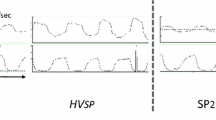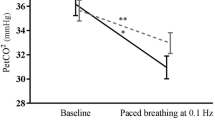Abstract
To explore if and how the common rebreathing (paper bag) approach to hyperventilation works, two experiments were carried out. In the first experiment, 12 normal volunteers, aware of the common physiological rebreathing rationale, were twice asked to overbreath intensely and then either to rebreath or to restart normal ventilation. Alveolar CO2 increased more quickly and physical symptoms disappeared earlier in the rebreathing condition. The second experiment had a similar design; however, this time the subjects were led to believe that, after both hyperventilation provocation tests, they were rebreathing in a semiclosed tube system. On one of the occasions, the tube system was, in fact, open. The CO2 restoration again differed in the two conditions. In this second experiment, the moment of symptom disappearance was not significantly earlier in the rebreathing condition. The combined results of the studies suggest that expectation and suggestion play a role in the effects of rebreathing approaches on hyperventilation.
Similar content being viewed by others
References
Cohen, M. E., and White, P. Q. (1951). Life situation, emotions and neurocirculatory asthenia (anxiety neurosis, neurostenia, effort syndrome).Psychosom. Med. 13: 335–357.
Garssen, B. (1986).Psychofysiologie van de ademhaling en het hyperventilatiesyndroom, Doctoral dissertation, Utrecht University, Utrecht, The Netherlands.
Garssen, B., van Veenendaal, W., and Bloemink, R. (1983). Agoraphobia and the hyperventilation syndrome.Behav. Res. Ther. 21: 643–649.
Griez, E., Pols, H., and van den Hout, M. A. (1987). Acid base balance in real life panic.J. Affect. Disorders 12: 263–266.
Gorman, J. M., Askanazi, J., Liebowitz, M. R., Fyer, A. J., Stein, J., Kinney, J. M., and Klein, D. F. (1984). Response to hyperventilation in a group of patients with panic disorder.Am. J. Psychiat. 141: 857–861.
Ley, R. (1985). Agoraphobia, the panic attack and the hyperventilation syndrome.Behav. Res. Ther. 23: 79–81.
Lum, L. C. (1981). Hyperventilation and anxiety state.J. Roy. Soc. Med. 1: 1–4.
Salkovskis, P. M., Jones, D. R. O., and Clark, D. M. (1986a). Respiratory control in the treatment of panic attacks: Replication and extension with concurrent measurement of behaviour and pCO2.Br. J. Psychiat. 148: 526–534.
Salkovskis, P. M., Warwich, H. M. C., Clark, D. M., and Wessels, D. J. (1986b). A demonstration of acute hyperventilation during naturally occurring panic attacks.Behav. Res. Ther. 24: 91–94.
van den Hout, M. A., and Griez, E. (1985). Peripheral panic symptoms occur during changes in alveolar carbon dioxide.Comp. Psychiat. 26: 381–387.
Woods, S. W., Charney, D. S., Loke, J., Goodman, W. K., Redmond, D. E., and Henninger, G. R. (1986). Carbon dioxide sensitivity in panic anxiety.Arch. Gen. Psychiat. 43: 900–909.
Author information
Authors and Affiliations
Additional information
This study was supported in part by the Dutch Organization for Fundamental Research (ZWO/Psychon 560-268-001).
Rights and permissions
About this article
Cite this article
van den Hout, M.A., Boek, C., van der Molen, G.M. et al. Rebreathing to cope with hyperventilation: Experimental tests of the paper bag method. J Behav Med 11, 303–310 (1988). https://doi.org/10.1007/BF00844435
Accepted:
Issue Date:
DOI: https://doi.org/10.1007/BF00844435




